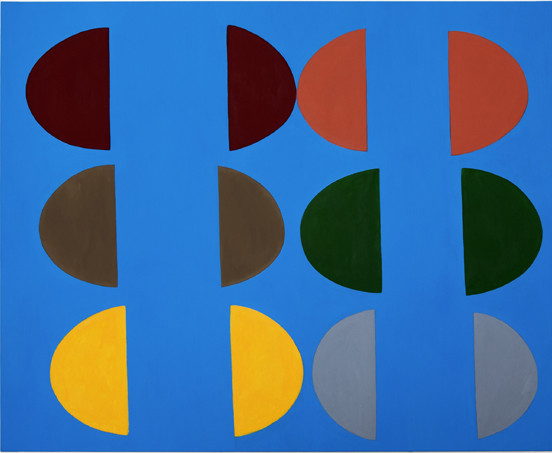Michael Bauch
07 Mar - 21 Apr 2012
MICHAEL BAUCH
7 March - 21 April, 2012
Michael Bauch’s paintings are signifying procedures towards form. His works are concentrations of a praxis with the material, here with canvas, primer and paint, through which Bauch has been specifying his understanding of what is painterly since the mid of the 1980s. However object-like his works are encountered by their audience, their specificity is a painterly one. But still, Bauch’s principle is not one of composition, but of action, a practical approach towards the canvas, contouring its space in a first approach with seemingly accidental, repetitive movements of drawing, to therein find forms, which are than elaborated and cleared. The intensive chromaticity, which Bauch applies to his paintings in the course of their development, can be identified as yet another differentiating step within this process of materialization.
In Bauch’s work form and color are sharpened in relation to one another, this becomes especially clear where he, like here at gallery KROBATH Wien, pursues such a repetition of form over a great number of canvases. Bauch shows two new series of paintings, which are reasserting, bending and newly adjusting their shaping again and again in different formats, together with a number of framed drawings, former preliminary studies, which gained sovereignty within the process, in the retrospection of their role. They turned into a stable format. And however abstract the forms may be that Bauch exercises here, they never fall into a graphic rigidification but are characterized by the indiscernible differences, which are becoming apparent only in their relentless repetition. It is those differences which are clearing the way for the viewer’s momentary figurative associations, projections which come into being within the gaze, unadulterated views and emanating from the individual connections to the painting. Those projections are not least founded in the medium’s pre-history, in memory pictures, which Bauch raises in his painting without directly quoting them. In Bauch’s paintings history is no tone of conoisseur-like referentialism but much rather an imprint of the history of the gaze. In this case, it is the impressions of the 1950s as much as the 80s, forms of Abstract Expressionism or early British Pop Art, which here return without either gestural monumentalism or informal tragic.
One begins to wonder if also the present occupies a discrete chromaticity and form, if it may consist in these intersections of the times, from the ongoing repetition, actualization and shifting of which contemporary art is made – or if it will step into the foreground only in retrospect, carved out, just as in Bauch’s painterly work with his material, in a form of open art history of the painterly gaze. Bauch paints painting as an artistic struggle within its material.
7 March - 21 April, 2012
Michael Bauch’s paintings are signifying procedures towards form. His works are concentrations of a praxis with the material, here with canvas, primer and paint, through which Bauch has been specifying his understanding of what is painterly since the mid of the 1980s. However object-like his works are encountered by their audience, their specificity is a painterly one. But still, Bauch’s principle is not one of composition, but of action, a practical approach towards the canvas, contouring its space in a first approach with seemingly accidental, repetitive movements of drawing, to therein find forms, which are than elaborated and cleared. The intensive chromaticity, which Bauch applies to his paintings in the course of their development, can be identified as yet another differentiating step within this process of materialization.
In Bauch’s work form and color are sharpened in relation to one another, this becomes especially clear where he, like here at gallery KROBATH Wien, pursues such a repetition of form over a great number of canvases. Bauch shows two new series of paintings, which are reasserting, bending and newly adjusting their shaping again and again in different formats, together with a number of framed drawings, former preliminary studies, which gained sovereignty within the process, in the retrospection of their role. They turned into a stable format. And however abstract the forms may be that Bauch exercises here, they never fall into a graphic rigidification but are characterized by the indiscernible differences, which are becoming apparent only in their relentless repetition. It is those differences which are clearing the way for the viewer’s momentary figurative associations, projections which come into being within the gaze, unadulterated views and emanating from the individual connections to the painting. Those projections are not least founded in the medium’s pre-history, in memory pictures, which Bauch raises in his painting without directly quoting them. In Bauch’s paintings history is no tone of conoisseur-like referentialism but much rather an imprint of the history of the gaze. In this case, it is the impressions of the 1950s as much as the 80s, forms of Abstract Expressionism or early British Pop Art, which here return without either gestural monumentalism or informal tragic.
One begins to wonder if also the present occupies a discrete chromaticity and form, if it may consist in these intersections of the times, from the ongoing repetition, actualization and shifting of which contemporary art is made – or if it will step into the foreground only in retrospect, carved out, just as in Bauch’s painterly work with his material, in a form of open art history of the painterly gaze. Bauch paints painting as an artistic struggle within its material.

